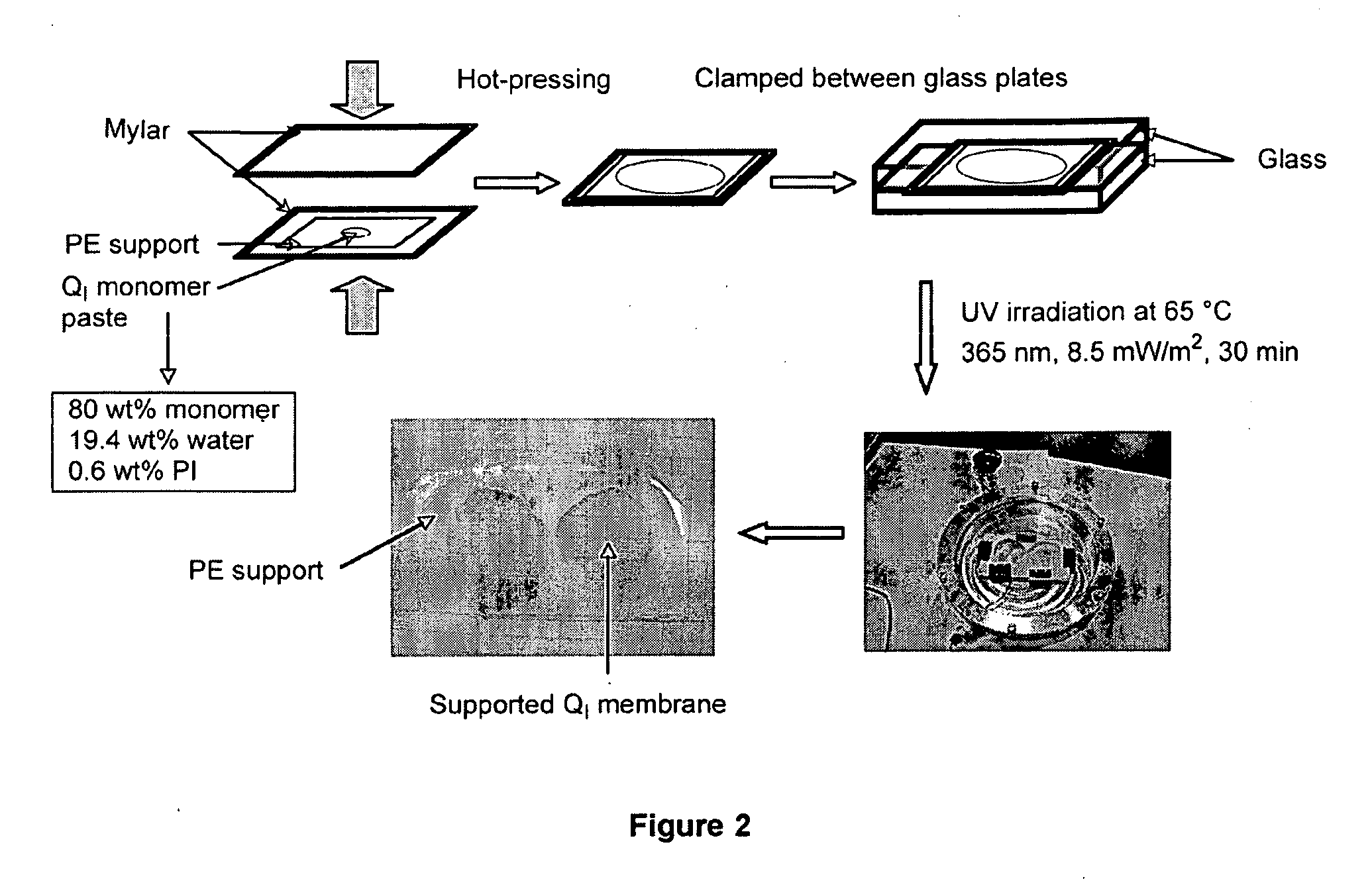Lyotropic liquid crystal membranes based on cross-linked type i bicontinuous cubic phases
- Summary
- Abstract
- Description
- Claims
- Application Information
AI Technical Summary
Benefits of technology
Problems solved by technology
Method used
Image
Examples
example 1
Fabrication of a Composite Membrane Based on a Cross-Linked Bicontinuous Cubic Lyotropic Liquid Crystal Assembly
[0093]A hot-pressing method similar to that used to make supported QI-phase 1-BR composite films (Lu, X.; Nguyen, V.; Zhou, M.; Zeng, X.; Jin, J.; Elliott, B. J.; Gin, D. L. Adv. Mater. 2006, 18, 3294) was employed to make supported membranes for NF testing, since conventional solvent-casting was ineffective. This method involves heating (70° C.) and pressing (12 tons force) the initial QI-phase monomer mixture [80.0 / 19.4 / 0.6 (w / w / w) monomer1 (y=6, x=10) / H2O / radical photo-initiator] into a 35-40 μm thick, commercial, microporous, hydrophilic, polyethylene fiber matte support (Solupor® E075-9H01A). In this process, the LLC monomer gel is completely infused through the support and then radically photo-cross-linked at 65° C. with 365 nm light to lock-in the QI phase (see below.). The presence of d-spacings with a ratio of 1 / √6:1 / √8 in the powder X-ray diffraction (XRD) profil...
example 2
Filtration Testing of a Composite Membrane Based on a Cross-Linked Bicontinuous Cubic Lyotropic Liquid Crystal Assembly
[0104]Table 2 shows the inorganic salt and organic solute rejection performance of supported QI-phase membranes of monomer 1 (y=6, x=10) obtained using a stainless steel, 25-mm I.D., stirred dead-end filtration cell at 400 psi applied pressure and 2000 ppm aqueous feed solutions. The percent rejections were determined by analyzing the concentration of the solutes in the permeate and retentate using ionic conductivity and / or total organic carbon analysis (see below for a more detailed explanation, values are the avg. of ≧3 independent runs with std. dev. error bars.). The QI-phase membranes can almost completely (95 to >99.9%) reject dissolved salts (NaCl, MgCl2, CaCl2); neutral molecules and macromolecules (glucose, sucrose, PEG-600); and molecular ions (Ethidium Red) in the 0.64-1.2 nm size range in one pass. Only solutes such as ethylene glycol (EG) and glycerol, ...
example 3
Fabrication of a Cross-Linked Bicontinuous Cubic Lyotropic Liquid Crystal Film
Synthesis of Monomer 4
Synthesis of 1,1′-(oxydi-2,1-ethanediyl)bisimidazole
[0124]This compound was prepared by a method similar to that described by Bara et al. (Bara, J. et al., J. Membrane Sci, 316 (2008), 186-191): A 500-mL 3-neck, round-bottom flask equipped with stir bar and reflux condenser was purged (while hot) 3 times by alternating vacuum and argon flush cycles. NaH (14.7 g, 368 mmol, 60 wt % in mineral oil) was added to the vessel. Anhydrous THF (250 mL) was added to the flask, and the mixture slurried. Imidazole (20.0 g, 294 mmol) was added slowly, while H2 gas evolved as a consequence of the neutralization reaction. The reaction was stirred at room temperature until gas bubbles were no longer visible. α,ω-oligo(ethylene glycol) ditosylate (147 mmol) was added via syringe. The reaction was sealed under argon and heated at reflux (65° C.) overnight. After this time, the solids were filtered and w...
PUM
| Property | Measurement | Unit |
|---|---|---|
| Fraction | aaaaa | aaaaa |
| Fraction | aaaaa | aaaaa |
| Pore size | aaaaa | aaaaa |
Abstract
Description
Claims
Application Information
 Login to View More
Login to View More - R&D
- Intellectual Property
- Life Sciences
- Materials
- Tech Scout
- Unparalleled Data Quality
- Higher Quality Content
- 60% Fewer Hallucinations
Browse by: Latest US Patents, China's latest patents, Technical Efficacy Thesaurus, Application Domain, Technology Topic, Popular Technical Reports.
© 2025 PatSnap. All rights reserved.Legal|Privacy policy|Modern Slavery Act Transparency Statement|Sitemap|About US| Contact US: help@patsnap.com



